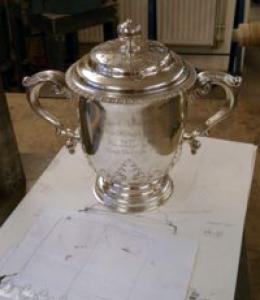Cecil was born in Prestatyn on 5 August 1905, the fourth of the six children of the Reverend Robert Stephen Edwards, Rector of Westcote Barton, Oxfordshire and his wife Annie Rosalie Tannat Price. Both his parents belonged to the Wrexham area and were Welsh-speaking, although his mother had been born in Java where her father, Thomas Pryce of Pentre Heylin Hall lived for many years. [Her brother Thomas Tannat Pryce was killed in 1918 having won the V.C & M.C. & Bar.]
In 1911, the family were living in Oxford at 25 St Margaret’s Road. Robert and Annie had been married for 13 years and had, at that time, five children one of whom had died.
Cecil was educated at Westminster School and matriculated in 1924. Coming up to Christ Church, he rowed number 3 in the 1925 Boat Race at a weight of 12st 3lbs. Oxford sank! In 1926, along with his brother, Hugh, he rowed number 7 at a weight of 12st 9lbs. Cambridge won by five lengths. Cambridge’s winning distance was down to three lengths by the 1927 race when Cecil was back at number 3 at the weight of 12st 10lbs. He rowed, also, in the Fours and the Pairs.
[Hugh, known as Jumbo, went on to row for Great Britain in the 1932 Olympics, winning a gold medal in the coxless pairs and was a legendary Oxford coach.]
Whether Cecil flew whilst up at Christ Church has not been found, but he was awarded his Aviator Certificate number 8197 on 30 November 1927. His occupation was given as Student, living at 56 Elsham Road, Kensington W14. He flew a D H Moth 30hp Cirrus.
On 30 April 1928, he was granted a permanent commission with the rank of Pilot Officer in the Royal Air Force General Duties Branch. He was promoted to Flight Lieutenant on 1 December 1932.
On 5 December 1930, with Winifred Spooner, he set out to prove that South Africa could be reached within 5 days by flying day and night. Unfortunately, after 16 hours whilst he was flying the aircraft and Winifred was asleep, the plane crashed into the sea off the coast of Belmonte Calabro in complete darkness. He could not give a reason for the plane steadily losing height without his knowledge. He could not swim and Winifred left him sitting on the wooden fuselage and swam ashore "6 strokes at a time". She then alerted local fishermen who rescued him and the plane Desoutter G-ABCU [She died of pneumonia in 1933 aged 32.]
In July 1931, forty pilots including four women, all amateurs, braved bad weather flying from Heston Aerodrome in the 1,000 mile race for 'The King's Cup. Cecil was the winner in a 'Blackburn-Bluebird. His original trophy is now the cup for the Prince of Wales Challenge cup at Henley Royal Regatta – see below. Also see video on British Pathe website.
Late in 1931, he was appointed to the School of Naval Co-operation, Lee-on-Solent.
In the 1933 King’s Cup, he was in second place overall in a Swift G-ABW. Although first across the line, the handicap brought him in three seconds behind the overall winner, Geoffrey de Havilland in a DH60 Moth
On 1 June 1940, he was promoted Wing Commander of 53 Squadron which had been given the Bristol Blenheim light bomber in January 1939 and moved to France in September. Following the German attack on France in May 1940, the squadron returned to England and undertook bombing and reconnaissance missions
Cecil was killed on 31 August 1940.
He is buried in Rotterdam Crooswijk General Cemetery Plot LL. Row 1. Grave 5.
His brother Hugh took over command of the Squadron. His youngest brother John Oswald Valentine Edwards was killed in Burma on 10 April 1942 and is remembered in Rangoon.
The 1931 King’s Cup presented to Cecil by Sir Philip Sassoon.
The alterations to the Trophy and the design and manufacture of the new base were undertaken by Steven Ottewill. This new trophy was contested for the first time at the 2008 Regatta.
The Two-Blade Laminated Propeller From The Blackburn Bluebird IV G-AACC, The King's Cup Air Race Winner, 25 July 1931, flown by Cecil, painted dark green finish with rivetted brass leading edges, 82in.(285cm) diameter. Provenance: The Royal Air Force Association, Newbury, was sold by Dreweatts for £400 in their Medals & Militaria Sale, 19 November 2008


